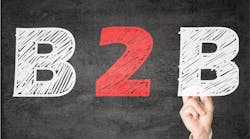Everything in our lives was affected by COVID-19 in one way or another. Some changes might be temporary; others might be permanent. Although our minds naturally paint a gloomy picture when we reflect upon the changes this pandemic has caused in our lives, some positive things might be here to stay after we’ve tamed the Coronavirus beast.
The B2B sales world has always been deeply affected by changes in society that bring upon changes in consumer behavior. And if COVID-19 has done nothing else, it has profoundly affected the way consumers interact with brands.
The numbers show a clear divide between the pre- and post-COVID B2B sales landscapes.
Tactics and actions that started out as crisis responses have become the new—or shall we say, the next—normal. The implications of the colossal shift towards digital forced upon B2B buyers and sellers by the pandemic are even bigger than the shift itself, which is very likely here to stay.
This “new” or “next” normal will emphasize certain characteristics that will make businesses more resilient, adaptable and “user-friendly,” such as:
- More support for people, customers and suppliers.
- A refocusing of the business to withstand new threats and seize new opportunities.
- Being able to navigate through rapid shifts in cultural norms, values and behaviors.
Let’s explore some of the trends and insights revealed by research conducted by McKinsey & Company. We’ll then take a tour of the five strategic steps to take now in order to capture the market share while keeping pace with the constantly changing customer demand.
B2B Sales Trends Pushed By COVID-19
Digital is the Way to Go
The new digital reality is here to stay. More than 75% of buyers and sellers stated that they “now prefer” digital, self-guided service and remote human interactions over in-person engagements. Even after lockdowns ended, this trend has continued to grow.
B2B sales leaders everywhere have shifted from being “forced” to adopt digital as a reaction to the global COVID-19 pandemic to a growing conviction that digital is truly the way to go. In fact, more than 80% of B2B buyers hope not to return to face-to-face interactions.
Digital Fear is Long Gone
B2B buyers are displaying a level of comfort in making large new purchases and reorders online that show the maturity of digital sales today.
E-commerce is no longer only for small-ticket items and fast-moving parts; today, 70% of B2B decision-makers say they are open to making new, fully self-serve or remote purchases in excess of $50,000, and 27% would spend more than $500,000.
This demonstrates that online remote selling is as effective, if not more so, than in-person sales. Sellers share this feeling, as most of them believe digital prospecting and social selling are as effective as their analog counterparts.
Video and Live Chat Rule!
COVID-19 gave the entire world a massive push towards digital transformation, making video and live chat the most predominant channels for interacting and closing sales with B2B customers. Customers have also made it clear that they prefer video to phone communication.
An eye-opening 43% of all B2B revenue comes directly from e-commerce and video conferencing. This is a 69% increase in the amount of revenue stemming from video-related interactions since April 2020.
An Optimistic Digital Future
Nine out of 10 decision-makers surveyed around the world optimistically state that the new digital go-to-market sales and commerce practices developed during COVID-19 will be a fixture throughout 2021 and beyond.
This sentiment is reflected in multi-year plans for increased spending on OpEx and CapEx.
Five Tips to Capture COVID-19-Induced Market Opportunities
2020’s global pandemic means we need to throw out the old rulebook and embrace the unpredictable new normal. Here are five new and different strategic steps you can explore now to capitalize on the opportunities created by the world’s constantly changing business environment.
1. Rediscover your Customer
- Stay close to stay relevant.
- Meet their new needs and continuously delight them.
- Find innovative ways of tapping into and understanding your customers’ needs.
- Proactively personalize your messaging with empathetic, custom messaging and value-driven solutions.
- Use your own powerful blend of social selling, predictive analytics and AI engines.
- Nurture meaningful customer connections.
- Data and insights are critical to surviving.
- Listen, learn and adjust as you go.
2. Refocus the Salesforce
- Define the new sales journey.
- Boost the effectiveness of virtual channels.
- Streamline your sales approach.
- Deliver more convenience and visibility to all customer interactions.
- Boost bold new ways of using virtual tools.
- Train your sales team on technology.
- Double down on high-value opportunities.
- Narrow the sales funnel by moving away from numerous unqualified opportunities.
- Ensure new wins stay won.
- Put your sales talent where the money is.
- Redefine the sales playbook.
- Focus on selling moments that matter.
- Harness the power of new lead sources.
- Forge virtual relationships.
- Update win strategies and sales materials to position your products and services to reflect the new needs and priorities of customers.
- Consistently monitor competitors and markets.
- Step up your sales coaching game.
3. Reimagine the Offer
- Embrace new narratives, approaches and terms.
- Anticipate massive shifts by understanding changing customer buyer patterns and unmet needs.
- Actively test and learn, then reposition your interactions, offers, messaging and deal terms accordingly.
- Retaining customers via creative commercial strategies.
- Mine for undetected customer needs.
- Reinvent and diversify dynamic offers.
- Create customized commercial terms.
4. Reset your Sales Approach
- Align, measure and incentivize for outcomes.
- Hone in on helping customers solve problems in both immediate and intermediate terms.
- Exceed customers’ needs now to demonstrate loyalty.
- Invest in gaining a greater understanding of existing customer needs and opportunities.
- Rally your workforce around newer and better concepts of value.
- Build an adaptive, future-ready workforce and culture.
- Concentrate on high-value markets and segments.
- Reallocate your go-to-market talent and coverage.
- Measure and incentivize differently.
5. Re-enable your Sales Team
- Make it real-time, guided and easy.
- Amplify your value proposition of innovative selling approaches.
- Leverage the power of emerging data insights and technology.
- Leap ahead of the curve fast by infusing your tech platforms with real-time data.
- Unlock the powerful potential of tech-driven marketing, sales and service platforms.
- Use insight-driven automated innovations to improve usability and deliver hyper-relevant insights.
- Enable extended account teams and leadership to collaborate better together.
- Pair predictive technology with tech-savvy talent.
Seize the Opportunity
COVID-19 has rapidly pushed digital adoption onto B2B organizations. However, the opportunities presented by this situation are the seeds to what the future and present of sales will be. This is a crucial moment for leaders to reinvent business models and reintegrate the value organizations provide into a new, changing societal landscape that demands bold business transformations.
The shift to virtual sales will help organizations like yours lower your cost per visit, extend your reach and significantly improve sales effectiveness while delighting customers who demand these new ways of interacting.
Remember that even if the opportunity is significant, there is also major pressure on businesses to capitalize on it. As a leader, you must define your commitment to further digital transformation into go-to-market models that derive a competitive advantage and perceived value for your customers.









